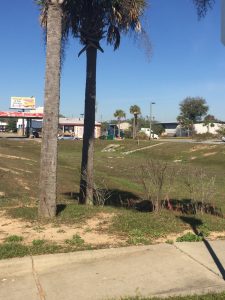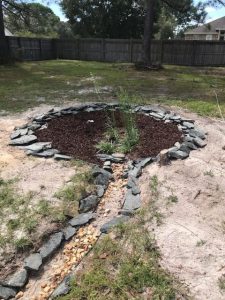Flooding and poor water quality are common issues of concern in the Florida Panhandle. Our frequent heavy rains cause water to quickly run off rooftop, parking lot, and driveway surfaces; this runoff water carries with it the chemicals deposited on land surfaces between rain events by direct application (such as landscape fertilizers) as well as through wind and circulation, a process referred to as atmospheric deposition. Surface water that runs off our developed urban and residential landscape is usually routed into stormwater drains and sewers, and then into stormwater detention ponds or directly into surface streams.
Conventional methods for dealing with stormwater runoff is through the use of stormwater ponds. Stormwater ponds allow water to slowly infiltrate into the soil before moving to streams or wetlands via shallow groundwater pathways. Typically hidden behind shopping centers or in the back of residential subdivisions, stormwater ponds attenuate flooding by delaying the time when water reaches the stream and are intended to improve water quality through microbial processes (such as denitrification) or plant uptake, particularly focusing on reducing the amount of nitrogen and phosphorus that reaches nearby streams. However, the efficacy of stormwater ponds is highly variable (many do not function as intended), and they often are visually unattractive aspects of a community.
Stormwater managers in other parts of Florida are increasingly utilizing a suite of management features termed “green infrastructure” as alternatives to stormwater ponds to reduce floodwaters and improve water quality before it enters nearby streams and wetlands. Green infrastructure, which includes features such as rain gardens, green rooftops, rainwater cisterns, bioswales, and permeable pavers, is designed to slow water down and reduce pollutant concentrations by mimicking natural processes of infiltration and biological uptake at its source—off the rooftops, driveways, roads, and parking lots where stormwater first concentrates. As a result, green infrastructure reduces surface runoff that occurs during storm events, leading to less flooding downstream. With the magnitude of peak flow reduced, stormwater runoff is also likely to carry lower amounts of pollutants downstream. In addition to their capacity to reduce flooding and improve water quality, green infrastructure can have many other benefits. It is often visually appealing, with vegetation typically selected to be visually attractive, appropriate for local conditions, and requiring low maintenance.
With our frequent rainfall, moderately developed urban areas, and expanding communities, the Florida Panhandle is ideal for using green infrastructure to reduce flooding and improve water quality. Features such as bioswales, rain gardens, and permeable pavement can be added to new development to mitigate stormwater runoff; they can also be added to existing neighborhoods to reduce flooding where roadside areas or other shared spaces allow. In addition to mitigating the effects of rainfall, green infrastructure can also improve property values because of their visual appeal. For green infrastructure techniques to be effective, they require widespread use throughout a neighborhood rather than at a handful of locations; so if it sounds like green infrastructure would benefit your community, talk with your neighbors and reach out to UF IFAS agents to discuss how it could be added to your community!
- Nature-Based Stormwater Solutions in the Florida Panhandle - July 14, 2023
- Urbanization and MS4s in Stormwater - May 8, 2020
- Green Infrastructure can Reduce Flooding and Improve Water Quality in the Florida Panhandle - March 13, 2020



